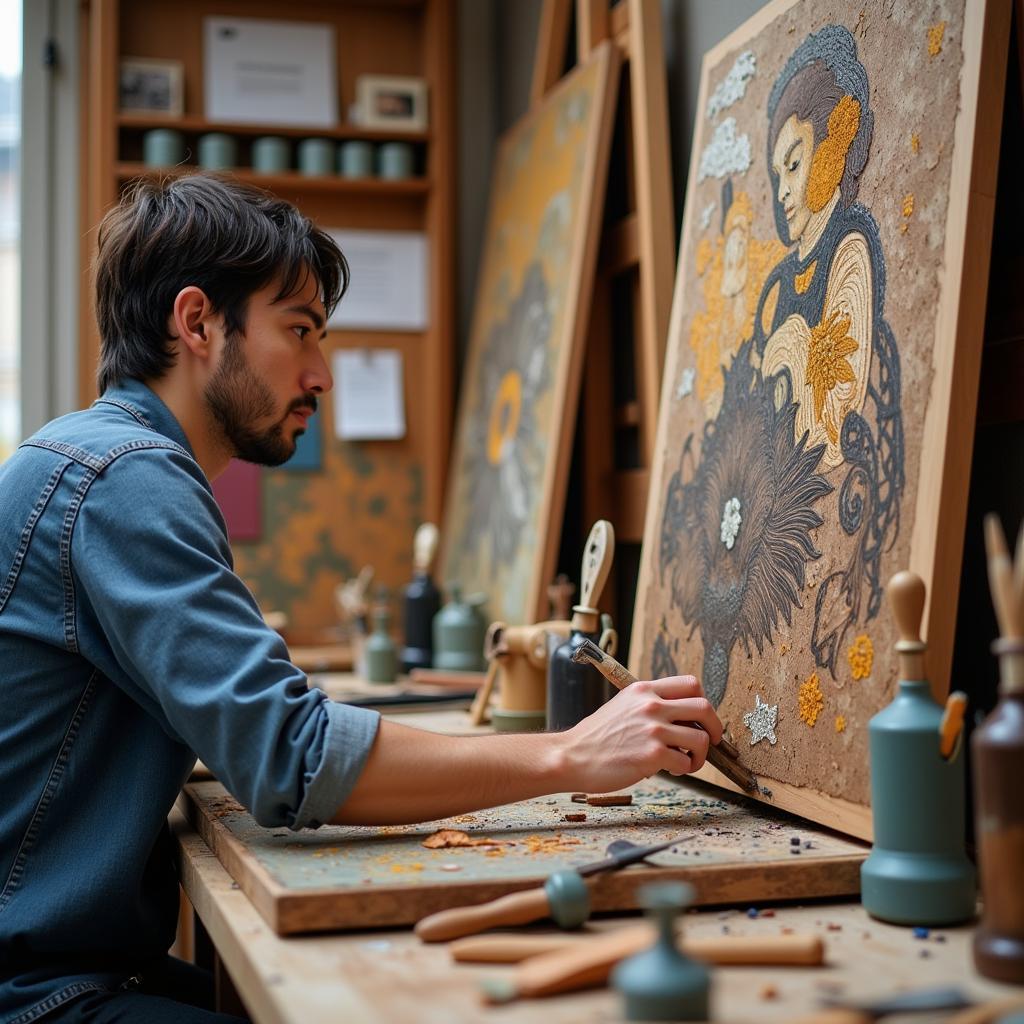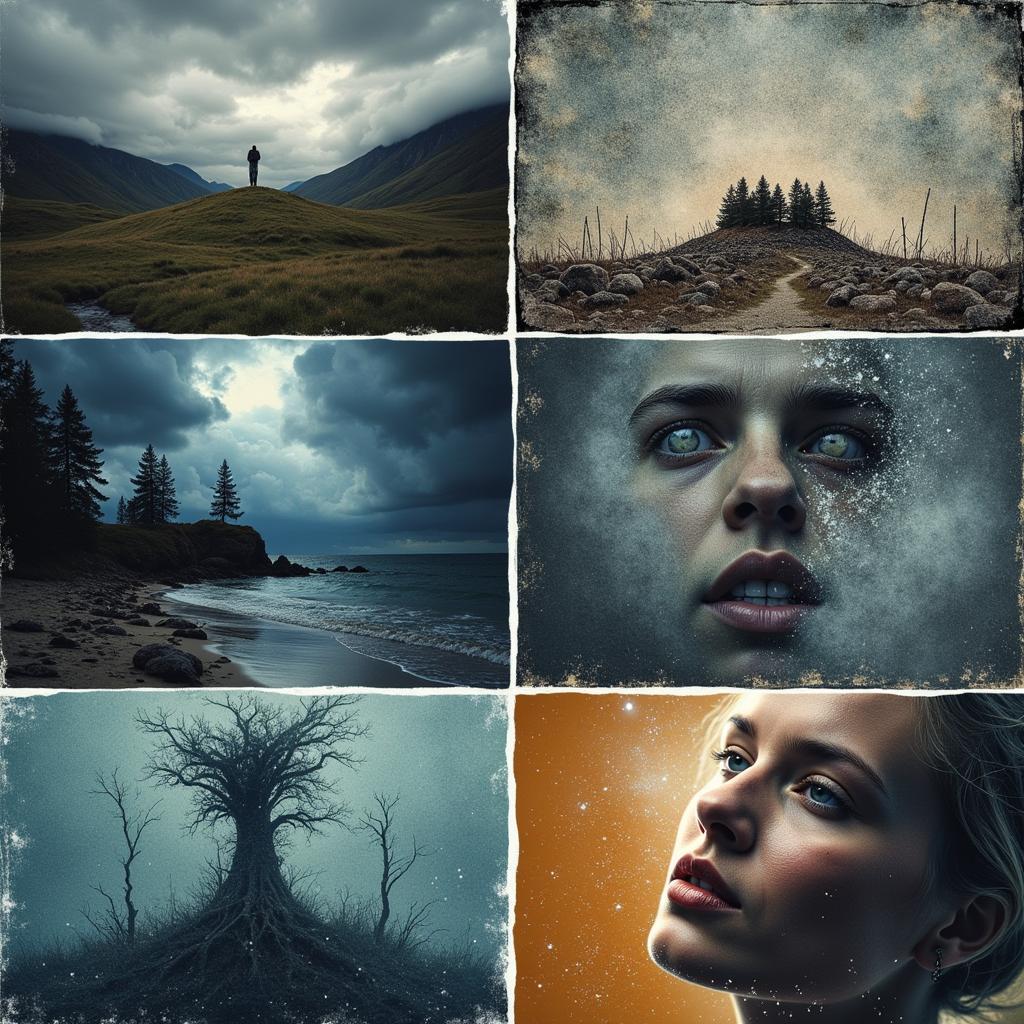Exploring the Mesmerizing World of Substrate Art
Substrate Art, a captivating fusion of art and surface, invites artists to break free from the confines of traditional canvases and explore the boundless possibilities of unconventional materials. From the sleek elegance of glass to the raw texture of wood, each substrate possesses unique characteristics that interact with paints, inks, and other mediums in captivating ways, adding a new dimension of depth and intrigue to the artwork.
Unveiling the Magic: What Exactly is Substrate Art?
Instead of limiting creativity to the standard canvas, substrate art embraces a world of textures, colors, and forms found in everyday materials. Imagine transforming a weathered piece of driftwood into an abstract seascape or breathing life into a discarded metal sheet with vibrant botanical motifs. That’s the essence of substrate art – where the canvas itself becomes an integral part of the artistic narrative.
Choosing the right substrate is like selecting the perfect dance partner. It’s about understanding its nuances and harnessing its strengths to create a harmonious blend of form and expression. A smooth, non-porous surface like glass will yield different results compared to a textured and absorbent material like wood.
Diving Deeper: Popular Substrates and Their Unique Appeal
The beauty of substrate art lies in its versatility and endless possibilities for exploration. Let’s delve into some of the most popular substrates and discover what makes them so captivating for artists:
- Wood: With its natural warmth, intricate grain patterns, and earthy tones, wood offers a rustic and organic charm. From reclaimed barn wood to polished birch panels, each piece carries a history that adds character and depth to the artwork. wooden mosaic wall art exemplifies the stunning visual impact achievable with this versatile substrate.
- Glass: The inherent elegance and translucency of glass lend themselves beautifully to ethereal and light-filled artworks. The smooth, non-porous surface allows for effortless blending and layering of colors, creating stunning effects with acrylic paints, inks, and resin.
- Metal: Industrial chic meets artistic flair with metal substrates. Whether it’s the rugged appeal of weathered steel or the sleek sophistication of copper, metal offers a unique platform for bold and contemporary art pieces.
- Textiles: From vintage fabrics to hand-woven tapestries, textiles introduce an element of texture, pattern, and cultural significance to substrate art. Embroidery, fabric painting, and mixed media techniques can be used to create visually rich and tactile pieces.
Why Choose Substrate Art? A World of Creative Freedom Awaits
Substrate art is more than just a trend; it’s a movement that’s redefining the boundaries of artistic expression. Here’s why artists and art enthusiasts are drawn to its unique allure:
- Unleashing Texture and Dimension: Substrates like wood and textiles inherently possess textures that add a captivating tactile dimension to the artwork, inviting viewers to engage with the piece on a multi-sensory level.
- Embracing Imperfections: The natural imperfections of substrates, such as knots in wood or the patina on metal, become integral parts of the artwork, adding character and uniqueness to each piece.
- Sustainable Art Practices: Upcycling and repurposing materials for substrate art aligns with eco-conscious values, transforming discarded objects into unique and meaningful works of art.
- Breaking Artistic Boundaries: Substrate art encourages experimentation and pushes the limits of traditional art practices, fostering a sense of playfulness and discovery in the creative process.
Tips and Techniques: Getting Started with Substrate Art
Ready to embark on your own substrate art journey? Here are a few pointers to get you started:
- Choose Your Substrate Wisely: Consider the desired aesthetic, the medium you’ll be using, and the overall mood you want to convey. Research different substrates and experiment with samples to find your perfect match.
- Prep Your Surface: Proper preparation is key to achieving optimal results. Clean your substrate thoroughly to remove dust, dirt, or oils that could interfere with paint adhesion. Depending on the material, you may need to prime or seal the surface before applying your chosen medium.
- Embrace the Unexpected: Don’t be afraid to experiment with different tools, techniques, and mediums. Let the unique properties of your chosen substrate guide your creative process and embrace the unexpected results.
 Artist Creating on Wood
Artist Creating on Wood
Substrate Art: Beyond the Canvas, Into the Heart of Creativity
Substrate art transcends the boundaries of traditional art, inviting us to see the beauty in everyday materials and unleash our creativity in unexpected ways. It’s a celebration of texture, form, and the boundless possibilities that emerge when art and surface intertwine. So, why not step outside the canvas and explore the captivating world of substrate art? Who knows what hidden masterpieces you might uncover within the heart of unconventional materials.
Frequently Asked Questions About Substrate Art
1. What are some other unique substrates to explore for art?
The world of substrate art is brimming with possibilities! Beyond the classics, consider experimenting with materials like:
- Leather: Perfect for adding a touch of vintage charm and rich texture.
- Stone: From smooth river rocks to rough-hewn slabs, stone offers a timeless appeal.
- Ceramics: Create functional and decorative art pieces with tiles, plates, or even broken pottery.
- Found Objects: Unleash your creativity by upcycling discarded items into unique artworks.
2. What types of paint work best on different substrates?
The ideal paint type depends on the substrate’s absorbency and texture:
- Acrylic paints: Versatile and work well on most surfaces with proper priming.
- Oil paints: Best suited for non-porous surfaces like glass or metal.
- Watercolors: Ideal for absorbent substrates like paper or wood, creating soft, ethereal effects.
- Alcohol inks: Create stunning, free-flowing designs on non-porous surfaces like epoxy art.
3. Can I combine different substrates in one artwork?
Absolutely! Mixed media art embraces the fusion of different textures and materials.
For example, you could incorporate pieces of abstract sea glass art into a wooden panel for a captivating interplay of textures and colors.
4. Where can I find moss art supplies and other unique materials for substrate art?
Craft stores, online art retailers, and even nature itself offer a treasure trove of materials for substrate art.
5. Are there any online resources or communities for substrate art enthusiasts?
Yes! Many online platforms and social media groups are dedicated to sharing inspiration, techniques, and connecting with fellow artists exploring the world of substrate art.
Need help with your substrate art journey? Contact us at Phone Number: 02462573573, Email: danteum@gmail.com Or visit us at Savico Megamall, 7-9 Đ. Nguyễn Văn Linh, Gia Thụy, Long Biên, Hà Nội 10000, Việt Nam. Our customer support team is available 24/7.


